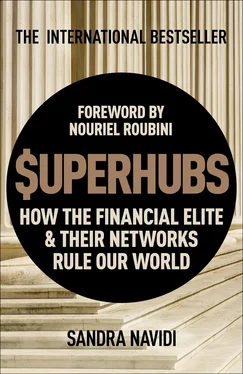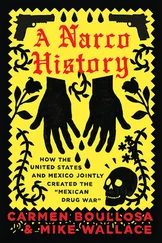Sandra Navidi - SuperHubs - How the Financial Elite and Their Networks Rule our World
Здесь есть возможность читать онлайн «Sandra Navidi - SuperHubs - How the Financial Elite and Their Networks Rule our World» весь текст электронной книги совершенно бесплатно (целиком полную версию без сокращений). В некоторых случаях можно слушать аудио, скачать через торрент в формате fb2 и присутствует краткое содержание. Год выпуска: 2017, Издательство: Hodder & Stoughton, Жанр: Старинная литература, на английском языке. Описание произведения, (предисловие) а так же отзывы посетителей доступны на портале библиотеки ЛибКат.
- Название:SuperHubs: How the Financial Elite and Their Networks Rule our World
- Автор:
- Издательство:Hodder & Stoughton
- Жанр:
- Год:2017
- ISBN:нет данных
- Рейтинг книги:4 / 5. Голосов: 1
-
Избранное:Добавить в избранное
- Отзывы:
-
Ваша оценка:
- 80
- 1
- 2
- 3
- 4
- 5
SuperHubs: How the Financial Elite and Their Networks Rule our World: краткое содержание, описание и аннотация
Предлагаем к чтению аннотацию, описание, краткое содержание или предисловие (зависит от того, что написал сам автор книги «SuperHubs: How the Financial Elite and Their Networks Rule our World»). Если вы не нашли необходимую информацию о книге — напишите в комментариях, мы постараемся отыскать её.
SuperHubs: How the Financial Elite and Their Networks Rule our World — читать онлайн бесплатно полную книгу (весь текст) целиком
Ниже представлен текст книги, разбитый по страницам. Система сохранения места последней прочитанной страницы, позволяет с удобством читать онлайн бесплатно книгу «SuperHubs: How the Financial Elite and Their Networks Rule our World», без необходимости каждый раз заново искать на чём Вы остановились. Поставьте закладку, и сможете в любой момент перейти на страницу, на которой закончили чтение.
Интервал:
Закладка:
Fink is the founder, chairman, and CEO of BlackRock, the largest asset management company in the world. Institutional investors entrust him with record amounts of money derived from “regular people’s” savings and pensions, and governments around the world ask him for advice. Fink is a prime example of how superhubs are linked to other players in the system via money, information, and opportunities. Moreover, he has all the usual superhub prerequisites: brilliance, a top education, and an alpha personality. After graduating from UCLA with an MBA, he joined First Boston in New York and made the bank hundreds of millions of dollars in a decade. Used to extraordinary success, he felt humiliated when fortunes reversed and he lost a hundred million dollars. His subsequent departure from the bank had the appearance of a firing and was the talk of Wall Street.
Fink drew several lessons from his failure, the first of which turned out to be groundbreaking: He realized that asset managers have an incomplete understanding of risk, especially when things are going well. He concluded that building risk management systems was one of the most fundamental necessities of successful portfolio management. In 1988, he cofounded his own company under the umbrella of the Blackstone Group, a private equity firm established by Steve Schwarzman and Pete Peterson, which extended a $5 million credit line to Fink and his partners in exchange for a 50 percent stake. Within only a few months, his business flourished. However, in 1992, Schwarzman and Fink, likely two of Wall Street’s biggest personalities, clashed over compensation and ownership issues and parted ways. Fink set out for bigger and better things and, accordingly, called his new firm BlackRock, a step up from Blackstone.
Fink has built an unparalleled global network. His bipartisan Washington ties and increasing involvement in political discourse have given him particular cachet. Fink further expanded his network by hiring high-profile former policy makers such as Philipp Hildebrand, the former governor of the Swiss National Bank, and Kendrik Wilson, a former U.S. treasury official. He is also said to have a close relationship with former U.S. treasury secretary Timothy Geithner, whom he reportedly had hoped in vain would join BlackRock at the end of his term. With all of his connections to those in power, Fink is now himself immensely powerful. He dedicates much of his time to developing and maintaining relationships and spends half of the year flying around the world to visit clients.
BlackRock’s financial links are ubiquitous. It controls trillions of dollars, more than most countries’ GDP and at times exceeding the Federal Reserve’s balance sheet. Through its management and advisory mandates, BlackRock is connected with most sovereign wealth funds, pension funds, central banks, endowments, and foundations. By the time of the financial crisis, BlackRock essentially had a monopoly on risk management and Fink had become known as “Mr. Fix-It.” Several governments retained BlackRock firm to help sort out the mess, and U.S. treasury secretary Geithner mandated it to analyze and sell $30 billion of risky mortgage securities. BlackRock was then retained to proceed in a similar fashion with AIG’s mortgage securities, a deal that eventually yielded a profit for taxpayers.
In line with Fink’s original idea, the firm’s core expertise centers on risk management. Thousands of computers operated by “rocket scientists” monitor tens of thousands of investment portfolios with proprietary quantitative programs. These systems process information input and, in turn, churn out even more valuable information with the help of sophisticated algorithms. The fact that BlackRock advises, analyzes, and manages so much money for so many institutional investors across the world gives it unique insights into the condition of the financial system as a whole. In addition, Fink himself is an information hub. His hyperconnectedness provides him with a high degree of valuable “information currency,” and his access to a vast personal network, capital, and information creates a wealth of opportunities.
NETWORK POWER: MONEY
The very fabric of the financial system is money. Money has transformative power and profoundly influences the way we organize our society and culture. The financial system, the economy, and markets are networks, with money connecting all three. Because it is one of the most ubiquitous links that connects nodes, hubs, and superhubs, money has serious network power. The flow of capital creates a web of transactions between market participants and links a wide network of financial institutions such as central banks, banks, and other financial firms. It creates relationships through credit, commerce, and trade; company shareholdings; and political contributions.
Money, as a means of exchange and store of value, exhibits typical network properties. For instance, paper currency travels in patterns and at a speed similar to viruses. When the money flow stops, economies grind to a halt, financial systems freeze, and markets become prone to collapse, as was evident throughout the crisis. Money is mostly created by banks offering loans.1 Central banks control the amount of money in an economy through the setting of interest rates and purchase of assets.
The network power of money extends to executives at the top of the financial system, who make decisions about its creation, allocation, and flow. The links created by money in turn form the base of the executives’ network power. Thus, networks create and impact money, while money creates and impacts networks. One of the most basic ways in which money connects people is through different types of institutions. The global financial system rests on several key pillars: central banks, “regular” banks, nonbank financial firms—the so-called “shadow banks”—and other financial institutions such as the Bank for International Settlements and the IMF. Many of these entities hold regular conferences where their executives maintain their ties.
The Printing Presses: Central Banks
Today almost all countries have central banks, which are independent government agencies, such as the Federal Reserve, the European Central Bank, or the Bank of England. Their mandate is to attain stable growth at low inflation and maintain the stability of the financial system. To achieve these goals, they use monetary policy: setting interest rates, regulating and supervising financial institutions, and providing liquidity in times of crises.
The European Central Bank (ECB) regularly holds conferences on its home turf in Frankfurt. Those meetings are usually matter-of-fact and technical. Leading central bankers and academics deliver presentations and papers on monetary policy, and participants have the opportunity to casually mingle. Guests frequently include the ECB president, ECB board members, the heads of the Bundesbank and the IMF, top executives from the European Commission, and many other central bank governors, senior policy makers, academics, bankers, and fund managers. These conferences usually coincide with the European Banking Congress, which most European bank CEOs attend. Policy makers such as the chairman of the U.S. Federal Reserve and finance ministers from around the world shuttle back and forth between conference venues and deliver talks to enlighten their audience of bankers. Speeches of senior policy makers are the highlights of any commercial event, yet another manifestation of how various different networks—in this case public and private ones—interact and reinforce each other.
Since 2008, central banks have pumped trillions of dollars into the global financial system to give politicians time to create more fundamental solutions. They now rank among the biggest investors in world markets.2 Central banking has become a quasi “asset class in and of itself” as they move global markets with their decisions. Because of their independence from politics, central banks are relatively unconstrained with regard to their actions as long as they maneuver within their mandate. In contrast to political institutions, they can make quick decisions and execute them. As a result, central bankers are now among the most powerful people in the world—in many respects more so than elected officials—due to the sheer scale of their financial firepower and their ability to quickly pull the trigger. They co-determine the course of the global economy and have a huge impact on all of our lives.
Читать дальшеИнтервал:
Закладка:
Похожие книги на «SuperHubs: How the Financial Elite and Their Networks Rule our World»
Представляем Вашему вниманию похожие книги на «SuperHubs: How the Financial Elite and Their Networks Rule our World» списком для выбора. Мы отобрали схожую по названию и смыслу литературу в надежде предоставить читателям больше вариантов отыскать новые, интересные, ещё непрочитанные произведения.
Обсуждение, отзывы о книге «SuperHubs: How the Financial Elite and Their Networks Rule our World» и просто собственные мнения читателей. Оставьте ваши комментарии, напишите, что Вы думаете о произведении, его смысле или главных героях. Укажите что конкретно понравилось, а что нет, и почему Вы так считаете.












